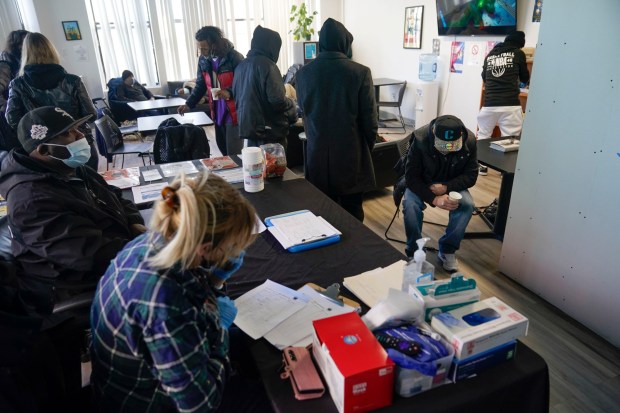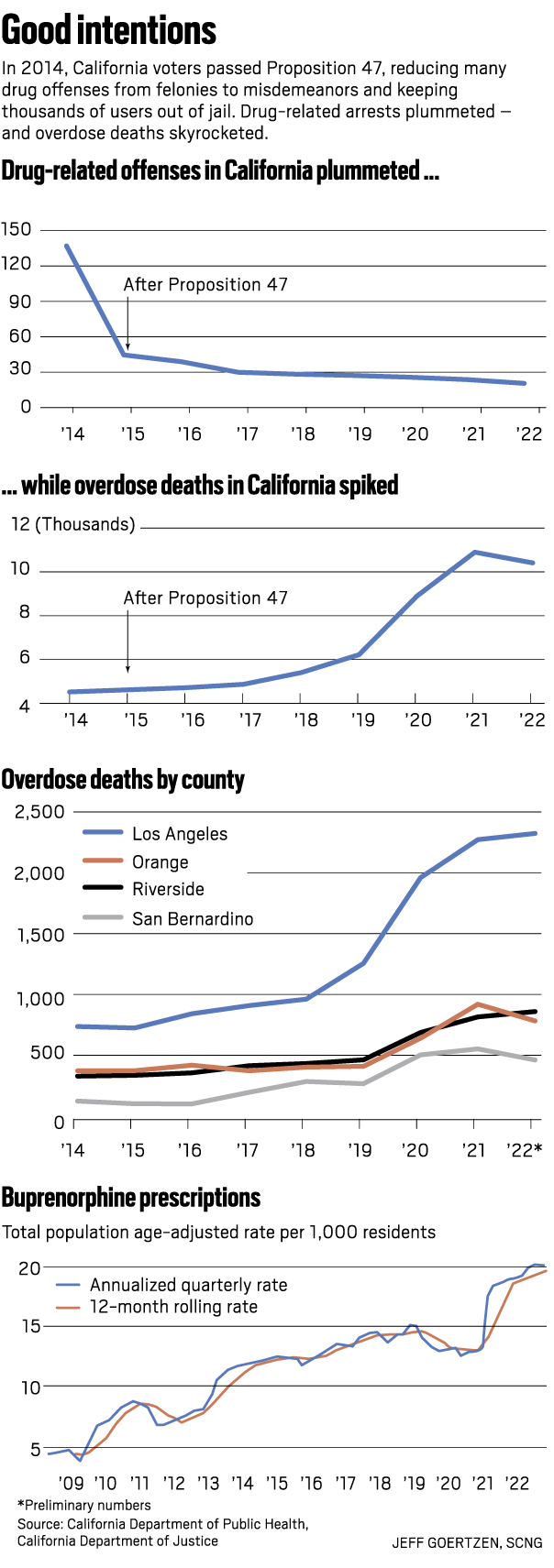
Once upon a time, California’s jails were stuffed with low-level drug offenders.
This was wastefully expensive for the public and wholly ineffective for the drug offenders, reformers argued.
So in 2014, with the best of intentions, voters passed Proposition 47. This reduced a great many drug-related offenses from felonies to misdemeanors, and kept a great many low-level drug offenders out of jail. The money saved on incarceration would go into effective addiction treatment, among other things, reformers said.
Since then, there has been an interesting, and perhaps tragic, convergence of events:
- Drug offense arrests have plunged 85% — from 137,054 in 2014 to 20,574 in 2022, according to data from the California Department of Justice.
- While drug overdose deaths have more than doubled — from 4,519 in 2014 to 10,410 in 2022, according to data from the California Department of Public Health.
Is there any relationship between these numbers? There’s heated debate over that.
Some folks — notably law enforcement and parent types — lament the loss of jail time as a carrot-and-stick to prod users into drug treatment. There are essentially no consequences now, they say.
Others — notably policy experts — say jail time was always an ineffective and dangerous response to drug use, and lament the dearth of effective treatment and harm-reduction strategies that can actually save lives.
This all plays out on a terrifying backdrop: The migration of cheap, powerful, deadly fentanyl into just about every single street drug; a global pandemic that destroyed any semblance of normalcy for years; and doctors’ tepid embrace of buprenorphine, the gold standard for opioid treatment.
“A perfect storm,” Orange County Sheriff Don Barnes said.
Enlightening, perhaps, are the overdose death rates in two states with very different approaches to drug criminalization — California and Texas.
They’re the largest states in America, population-wise. Both border Mexico, where fentanyl-laced drugs enter the U.S., according to the U.S. Drug Enforcement Agency.
One of those states has a much lower overdose death rate than the other. Can you guess which one?
Fentanyl: primary force
“There are a bunch of moving parts here,” noted Andrew Noymer, epidemiologist and demographer at UC Irvine.
“In some sense, the two trends are explainable in a vacuum. You get fewer arrests because Prop. 47 is working as intended, quote-unquote, and more deaths because of fentanyl infiltration. It’s all a bit unfortunate. In some sense, it’s just inopportune timing.”
Fentanyl is the primary force propelling the spike in overdose deaths not just in California, but nationwide, agreed Maryanne Diaz, a lecturer in the School of Criminology, Criminal Justice and Emergency Management at Cal State Long Beach.
“The rise in overdoses is not a result of Prop. 47,” she said by email. “Arrests and short jail stays, as were utilized for low-level drug offenses prior to Prop. 47, are a considerable risk factor for overdose.”
When a person who uses drugs is arrested and detained, even for less than a day, their tolerance decreases, she said. If they use again after release, they’re more likely to overdose. It’s much the same with short-term detox and treatment.

California’s reluctance to embrace evidence-based policies and programs hasn’t helped, she said. Treatment is underfunded and can be hard to get. Last year, Gov. Gavin Newsom vetoed a bill that would have launched pilot “safe injection sites” in Los Angeles, Oakland and San Francisco. In New York and Vancouver, facilities like this are manned by medical staff and offer testing kits so users know what’s in their drugs. Overdose deaths have dramatically dropped in these neighborhoods. They boost access to treatment and improve public safety, she said.
Diaz has a study under review showing that the majority of California voters would support an overdose prevention site. In the meantime, more harm-reduction efforts like syringe exchanges, drug education, naloxone and fentanyl testing strips could help — but are repeatedly met with injunctions and legal hurdles.
Treatment should not be coerced, and should never be contingent on involvement in the criminal justice system, she said.
‘Reclassifying drug crimes because of Prop. 47 is not why we are seeing such high overdose rates,” Diaz said. “Fentanyl, an ever-changing drug supply and a lack of harm reduction programs are why we are seeing high overdose deaths.”
It’s sobering to consider that, but for the back-from-the-dead drug naloxone, which can reverse opioid overdoses, the death rate would be even higher.
‘Complete turnaround’

Law enforcement types and some parents don’t necessarily disagree, but feel hamstrung.
Using the corrections system as a cudgel — go to treatment, or go to jail — can inspire resolve that might otherwise be lacking.
“I never ever thought I would be OK with my child being incarcerated,” said a mom whose daughter cycled through myriad addiction treatment programs in California, then wound up convicted of possession in a Midwest state with tough drug laws. Behind bars, she had mandatory treatment.
“It’s such a complete turnaround,” said the mom, who we’re not naming to protect her daughter. “She’s been clean for a year now. We feel like we have our daughter back.”
Prop. 47 aimed to ensure that spending focused on violent and serious offenses, maximized alternatives for non-violent crime and invested savings in prevention and support programs for schools, victims services and mental health and drug treatment. It passed in 2014 with nearly 60% of the vote.
It can certainly be argued that there hasn’t been a vast expansion of quality drug treatment in its wake. There have been several legislative attempts to rein in Prop. 47 — or repeal it altogether — but those focused on an “explosion” of property crimes, smash-and-grab robberies and shoplifting that legislative analyses said were exaggerated and/or erroneous, and got nowhere. An online petition to repeal Prop. 47, though, has gathered 105,000 signatures.
“Criminals using dangerous drugs such as methamphetamines and heroin now face little or no repercussions from law enforcement officers,” says the petition by Debbie Rouser of San Pedro. “Unfortunately these same criminals that use drugs and commit ‘petty theft’ crimes are the same criminals that commit violent acts and home burglaries.”
Deon Joseph, a law enforcement consultant who has worked for the Los Angeles Police Department for a quarter-century, said, “I hate to say I told you so” shortly after Prop. 47 passed.

“We have chosen idealism over our safety. We have chosen to be test subjects in social experiments over common sense,” he wrote on his blog. “I actually agree with making mere possession a misdemeanor, but a misdemeanor with some teeth at least…. There is zero incentive now for addicts or dealers to stop their crimes or seek help.”
Long before Prop. 47, offenders had many alternatives to time behind bars, said Barnes, O.C.’s sheriff.
“You had to try really hard to go to jail. There were a lot of programs available, and a potential felony was a great incentive to get into treatment and sobriety. That no longer exists. Misdemeanor consequences just aren’t as high.”
That — coinciding with the arrival of fentanyl — has contributed to the significant rise in drug-related deaths, he said.
“I am not advocating for incarceration,” Barnes said, “but there’s no longer an opportunity for intervention. Accountability measures play in. Coupled with the fentanyl and lack of border security, it’s a perfect storm.”
It’s important to understand that drug offenders and/or dealers with significant rap sheets still wind up behind bars. On any given day, about one-quarter of the Orange County jail’s population — some 900 to 950 people — who are getting medication-assisted treatment, Barnes said. That’s methadone, naloxone, buprenorphine — drugs that manage opioid cravings and give users a much better shot at sobriety. Some 100 to 120 people are in medically supervised detox.
“What I don’t have is the off-ramping — the robust, post-custody sustained treatment system to hand them off to — so they don’t fall back into the criminal justice system,” he said. “I keep seeing the same faces over and over again.”
If Barnes could wave his magic wand, there would be robust systems in place to help people at the front end, tight border control to keep fentanyl out, education programs to address demand — and professional policing would get out of social work.
Crime and punishment
As we were running these numbers by the experts, UCI’s Noymer gave us homework.
You need to gather more stats on overdose deaths in other places, he said. He suggested Oregon, a state with similarly relaxed drug laws. We suggested Texas, a state with contrastingly tough drug laws.

Here’s what we found:
- In California, the overdose death rate is 26.6 per 100,000 people, according to the U.S. Centers for Disease Control.
- In Oregon, it’s a tad higher, at 26.8.
- And in Texas, with some of the nation’s toughest drug laws, it’s just 16.8.
There’s a lot to think about there.
“At face value, looking at how much less punitive California has become in the last decade, it seems to show Prop. 47 had the opposite effect of what Californians were hoping for,” said Barnes, O.C.’s sheriff.
But Diaz, of Cal State Long Beach, said there’s more than meets the eye.
“Yes, the overdose deaths in California and Oregon are higher than Texas,” she said. “But it’s important to look at that CDC data all together. California and Oregon, despite having more relaxed drug possession laws, have lower overdose rates than 33 other states, including more punitive states like Arizona, New Mexico and Florida…. The data just does not indicate that decriminalization and less punitive drug laws cause overdoses to increase.”
She’s happy to hear that the young lady who wound up in jail found her way to recovery, and Diaz empathizes deeply with what she went through. She also has immediate family members who struggle with substance use. “I used to rely heavily on the criminal justice system to try and force my family members to stop using. However, no matter how many arrests or jail stays they had, their substance use persisted. … I actually often saw my family member’s overall health (substance use, physical health, psychological health) deteriorate the more often they were arrested and incarcerated.”
Many people credit jail with attaining recovery, but the research is clear on mandated treatment, she said.
“Motivation for change is one of the biggest predictors of success. If a person is mandated to treatment, their likelihood of success is very low. So, it wasn’t necessarily the incarceration experience that was the conduit for change, but the individual’s shift in desire to use or not use while they were in jail. … This same change could occur outside of carceral spaces if treatment were more readily available and accessible.”
The criminal justice system is the nation’s largest mental health provider, providing one of the widest onramps to addiction treatment via drug courts, diversion, in-prison treatment, probation conditions and the like. Once involved with the criminal justice system, people can access treatment resources they didn’t have on their own, she said.
“The criminal justice system, though, is not the best place for this,” she said. “In an ideal world, we would have a system with the same resources and access as the criminal justice system that would be able to provide resources and treatment to people without the trauma and collateral consequences (criminal record, stigma, etc.) of incarceration.”
On that, she and Barnes certainly agree.
This post was originally published on this site be sure to check out more of their content.






